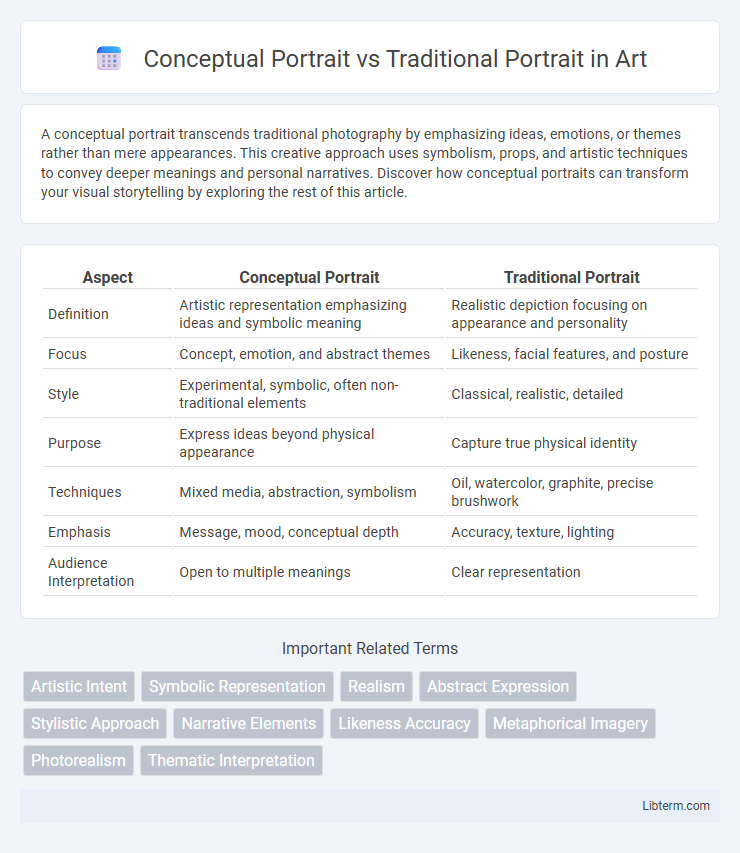A conceptual portrait transcends traditional photography by emphasizing ideas, emotions, or themes rather than mere appearances. This creative approach uses symbolism, props, and artistic techniques to convey deeper meanings and personal narratives. Discover how conceptual portraits can transform your visual storytelling by exploring the rest of this article.
Table of Comparison
| Aspect | Conceptual Portrait | Traditional Portrait |
|---|---|---|
| Definition | Artistic representation emphasizing ideas and symbolic meaning | Realistic depiction focusing on appearance and personality |
| Focus | Concept, emotion, and abstract themes | Likeness, facial features, and posture |
| Style | Experimental, symbolic, often non-traditional elements | Classical, realistic, detailed |
| Purpose | Express ideas beyond physical appearance | Capture true physical identity |
| Techniques | Mixed media, abstraction, symbolism | Oil, watercolor, graphite, precise brushwork |
| Emphasis | Message, mood, conceptual depth | Accuracy, texture, lighting |
| Audience Interpretation | Open to multiple meanings | Clear representation |
Introduction to Portrait Photography
Conceptual portrait photography emphasizes creative storytelling and symbolic elements within the image, contrasting with traditional portrait photography's focus on capturing realistic likeness and personality. This approach allows photographers to convey deeper meanings or abstract ideas through visual metaphors, enhancing emotional impact. Techniques in conceptual portraits often include unusual poses, props, and digital manipulation, distinguishing it from the conventional use of natural lighting and straightforward compositions in traditional portraits.
Defining Conceptual Portraits
Conceptual portraits emphasize creative expression and abstract ideas over realistic representation, often using symbolism, unusual poses, or mixed media to convey deeper meanings. Traditional portraits focus on accurate likeness, capturing the physical appearance and personality of the subject in a realistic manner. Conceptual portraits challenge conventional norms by prioritizing artistic interpretation and thematic storytelling.
Understanding Traditional Portraits
Traditional portraits emphasize realistic representation, capturing the subject's physical features, expressions, and personality through meticulous detail and accurate proportions. Artists prioritize lighting, composition, and natural poses to convey authenticity and status, often reflecting historical or cultural contexts. This approach aims to preserve the likeness and essence of the individual in a timeless manner.
Key Differences Between Conceptual and Traditional Portraits
Conceptual portraits emphasize symbolic meaning, creative expression, and abstract ideas, often incorporating unique props, lighting, and settings to convey a message or emotion beyond physical resemblance. Traditional portraits focus on realistic representation, capturing the subject's likeness, personality, and status through classic compositions, natural poses, and conventional studio lighting. The key difference lies in conceptual portraits prioritizing artistic interpretation and storytelling, while traditional portraits aim for accurate depiction and timeless elegance.
Artistic Intent and Expression
Conceptual portraits emphasize artistic intent by conveying abstract ideas, emotions, or narratives through symbolic elements and unconventional compositions, prioritizing expression over realism. Traditional portraits focus on accurate representation and capturing the subject's physical likeness, often highlighting personality through detailed features and realistic techniques. The distinction lies in conceptual portraits using visual metaphors to provoke thought, while traditional portraits aim for faithful depiction and timeless character portrayal.
Composition and Visual Storytelling
Conceptual portraits emphasize innovative composition by integrating symbolic elements and creative framing to convey deeper narratives beyond mere likeness. Traditional portraits prioritize balanced composition with clear, focused depiction of the subject's physical features, aiming to capture personality and status. Visual storytelling in conceptual portraits relies on abstract or thematic cues, while traditional portraits use realistic detail and posture to communicate identity and emotion.
Use of Props and Settings
Conceptual portraits employ props and settings symbolically to convey abstract ideas or themes, often transforming ordinary objects into visual metaphors. Traditional portraits use props and settings realistically to highlight the subject's identity, social status, or personality, maintaining a naturalistic representation. The intentional use of props in conceptual portraits challenges viewers to interpret deeper meanings, whereas traditional portraits rely on familiar contextual elements to reinforce the subject's character.
Subject Interaction and Posing
Conceptual portraits emphasize creative expression, encouraging subjects to interact with symbolic elements or abstract ideas, resulting in dynamic, interpretive poses that convey deeper narratives. Traditional portraits focus on formal posing with direct eye contact and classic head-and-shoulder framing, aiming to capture the subject's likeness and personality with clarity. Subject interaction in conceptual portraits often breaks conventional posing rules, allowing more freedom for emotion and storytelling through body language and props.
Emotional Impact and Viewer Engagement
Conceptual portraits prioritize emotional impact by conveying abstract ideas and complex narratives that provoke deeper viewer reflection and personal interpretation. Traditional portraits emphasize realistic representation and capture the sitter's physical likeness and personality, fostering immediate recognition and emotional connection. Viewer engagement in conceptual portraits arises from intellectual curiosity and interpretive challenges, while traditional portraits rely on empathy and familiarity to evoke emotional responses.
Choosing the Right Style for Your Vision
Conceptual portraits emphasize creative storytelling and abstract ideas, making them ideal for artists seeking to convey complex emotions or narratives through symbolic imagery. Traditional portraits focus on realistic representation, capturing the subject's physical appearance and personality with accuracy and detail. Selecting the right style depends on whether your vision prioritizes artistic expression and metaphorical depth or faithful and classic depiction of the individual.
Conceptual Portrait Infographic

 libterm.com
libterm.com